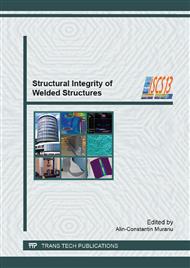p.76
p.82
p.87
p.99
p.104
p.110
p.115
p.123
p.127
Studies on the Material Anisotropy Influence in Case of Sheets Made From Magnesium Alloy AZ31B on the Stress Concentration Factor in the Presence of a Circular Concentrator
Abstract:
This paper presents an experimental study regarding the behaviour and the durability o a magnesium alloy sheet designed with a circular stress concentrator, tested for different angles between the tensile direction and the rolling direction of the sample material. To perform this study the experimental tests has been carried out on samples machined for different angles values the material rolling direction and the main axis of the sample: 0°, 15°, 30°, 45°, 60°, 75° and 90°. The experimental tests have been done on samples with and without circular stress concentrator. From the analysis of the obtained results, it can be concluded that the sheet made from magnesium alloy, shows a very pronounced variation of the tensile strength and yield strength depending on the material rolling direction. At the same time, the effect generated by the presence of the circular stress concentrator it is significantly influenced by the anisotropy of the AZ31B magnesium alloy.
Info:
Periodical:
Pages:
104-109
Citation:
Online since:
September 2013
Authors:
Price:
Сopyright:
© 2013 Trans Tech Publications Ltd. All Rights Reserved
Share:
Citation:


